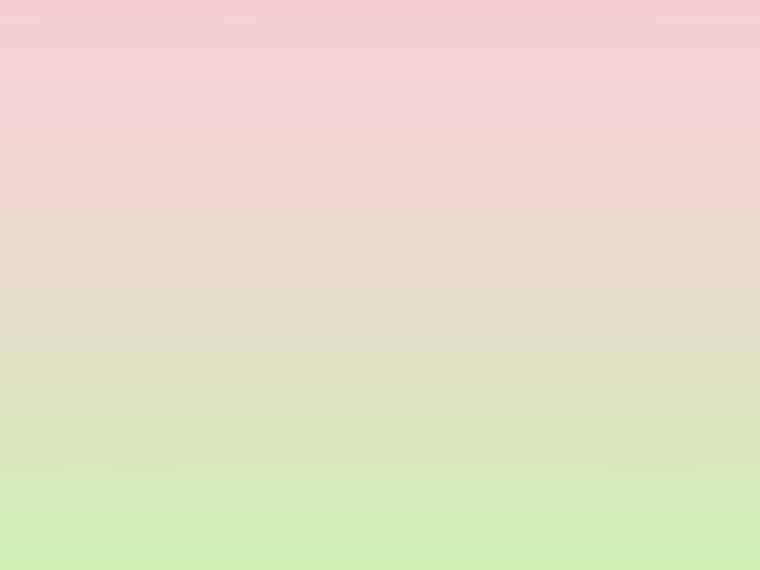Have you ever wondered what color pink and green make when mixed? When you mix green and pink, it’s the same as when you mix primary complementary colors or primaries. Let’s find out more!
Pink and green is a classic combo because the pink softens and warms the green. On the other hand, green tones provide freshness while keeping the pink earthy.
Both are vibrant colors, but when you mix them, you get the opposite color. That’s because pink is actually a hint of red, whose complementary color is green.
And according to color theory, when you mix pink and green, it’s like mixing complementary colors. You get a muddy, dark color result.
But what color do green and pink make when they’re mixed together?
What Do Pink and Green Make in Painting?
When pink and green colors are mixed, the color produced is usually brown, sometimes gray, or olive, depending on your base colors.
However, it usually results in a muddy brown compared to the mix of red and green, which makes a rich brown.
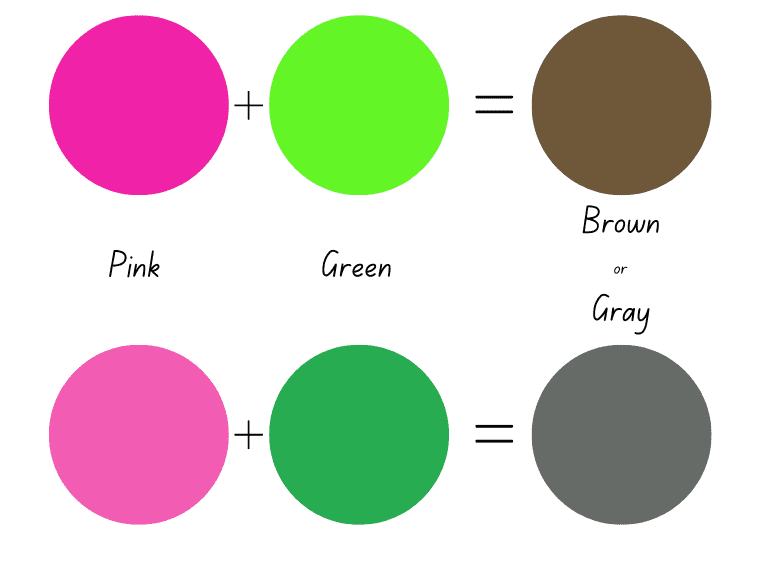
When you mix green and pink paint, it is similar to mixing red and green because the mix involves all three primary colors of the RYB model: red, yellow, and blue.
That’s because pink is a hint of red, and green is a mix of blue and yellow.
If you mix red, yellow, and blue in equal proportions, you will create brown. However, it’s not the same rich brown as when you mix red with green, but rather a muddy brown.
Understanding the Color Theory
There is a traditional pattern that is used in art, and it is called RYB. This color space uses red, yellow, and blue as primary colors.
When two of these colors are mixed, they create secondary colors like green, orange, and purple.
If you mix adjacent primary and secondary colors, you create intermediate colors. If you combine secondary colors, you create tertiary colors.
Furthermore, the RYB space is a subtractive model. Subtractive color starts with white (a piece of paper), and as color is added, it gets darker.
The reason why colors in RYB get darker when mixed has to do with how the pigments in the paint interact.
Each pigment absorbs and reflects different wavelengths of light. Therefore, when two pigments are mixed, they absorb some of the wavelengths of light that they would normally reflect, making the resulting color appear darker.
Other Ways to Mix Brown and Gray
What colors make brown? If you want to create brown or gray, there are several solutions. The easiest way is to mix the primary colors – red, yellow, and blue – equally. Another method is to mix the primary complementary colors: blue and orange, yellow and purple, or red and green.
So mixing pink and green is a challenging solution. That’s because you have to create pink by mixing red and white, and then make green by mixing blue and yellow.
If you want to create gray, add white paint to a black base until you reach the desired shade. This way, you will get a pure gray without green undertones from mixing pink and green.
Mixing Lighter or Darker Colors
When you mix green and pink, you’ll unlikely get the desired shade of brown or gray. That’s because the result is more of a muddy brown or gray with blue undertones. At least, the gray resembles Oslo Gray.
However, you can create different shades or tints.
Making Tints
To create a tint, you need to lighten up the color. In order to create a tint, you should add white paint to the mix. So the darker the mixed color, the more white paint you need to add to open it up.
Making Shades
Unlike tints, lighter versions of color, shades are darker versions of a base hue. To make a shade, add black paint to the mix.
Unlike white paint, which you need to add more to lighten a dark color, black is very strong and can dramatically change the color.
Brown and Gray Meanings
Brown si gray sunt considerate neutre in design, fiind un combo comfortant si sofisticat. Inainte de a le folosi, iata care sunt intelesurile acestor culori.
Gray Meaning
Gray is associated with balance and neutrality. It combines black’s elegance and sophistication with white’s simplicity and clarity.
Grey is also associated with maturity, reliability, and intellect.
Furthermore, gray calms down, relaxes, and stabilizes.
This color, on the other hand, is associated with pessimism and sadness.
Brown Meaning
Brown is an earthy color that grounds, simplifies, and stabilizes. Furthermore, brown is associated with comfort, stability, and honesty. It also evokes warmth and security in all circumstances.
Sometimes it can seem monotonous and predictable.
Do Gray and Brown Go Together?
Yes, they do! It’s a classic combination. They are both neutrals. Gray is a sophisticated and elegant color, whereas brown is the color of comfort and stability.
What Do Pink and Green Make in Lighting?
The light works with the RGB model, where the primary colors are red, green, and blue. These primaries differ from traditional art (RYB), where green is replaced by yellow.
So, what does pink and green make?
When it comes to light, pink and green make white, unlike pigment mixture, which makes brown or gray. The light uses additive color mixing, while pigment uses subtractive color mixing.
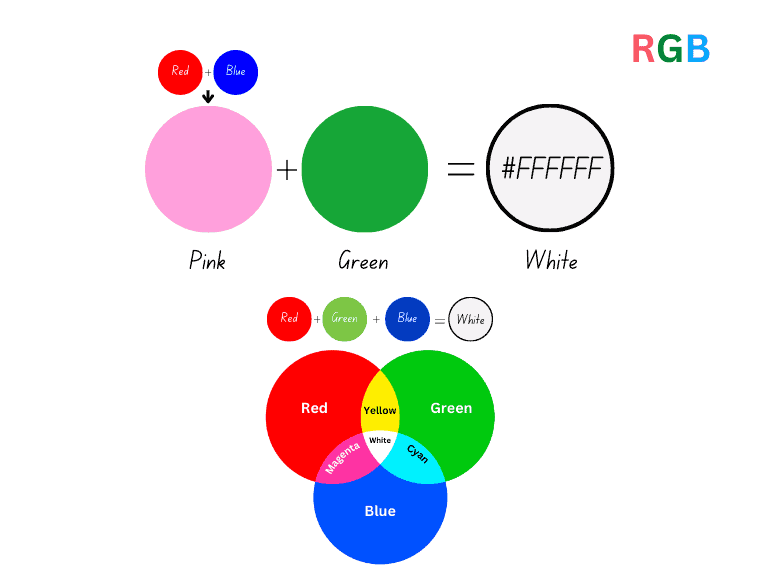
Besides the fact that RGB uses different primary colors, so a different color wheel, it also involves a different color mixing model. Colored lights are mixed additively, as opposed to pigment, which is mixed in a subtractive way.
When the primary colors (red, green, and blue) are mixed, they make white. And pink and green in light is a mix of all the primary colors (red, green, and blue). How does this happen?
Understanding the RGB Color Model
The RGB color space is an additive model used for lights, including anything that emits light, from smartphones and laptop screens to TVs and monitors.
This model uses three primary colors (red, green, and blue) adapted to trichromatic human vision.
Basically, a healthy human eye has specific cells in the retina called cones and rods. These are the image-capturing receptors of our color vision. They are sensitive to the wavelengths of these colors (red, green, and blue).
In RGB, each primary color is encoded as a number between 0 and 255. This range starts at zero light (0) and goes up to the maximum brightness of a color (255).
As we have seen, pink is a lighter variation of red created by mixing red and white. But in RGB, things are different.
Pink is made up of red at maximum brightness (255) and blue starting at medium brightness (100 – for hot pinks) to maximum when it approaches magenta (255).
To get dusty pinks, overlap green with a brightness between 128 and 200.
Starting with a brightness of 200 for green, the pink becomes paler. When you reach the maximum value of the three, you get white.
Thus, this additive model works quite simply. It overlaps colored lights as layers at different brightness levels.
When two or more RGB layers are placed on top of each other at different brightness levels, the resulting color will be a blend of the colors of the individual layers.
White Meaning
White is a neutral color that carries a multitude of meanings. It is associated with purity, innocence, and perfection.
Moreover, it symbolizes cleanliness, goodness, clarity, and hope.
Others, however, perceive this color as cold, empty, and distant.
What Do Pink and Green Make in Printing?
When it comes to the printing industry, we’re referring to the CMYK model. Its primary colors are cyan, magenta, and yellow. These are the primary subtractive colors because CMYK is a subtractive space.
Mixing cyan, magenta, and yellow together results in black. Mixing two of the three colors results in additive colors (red, green, and blue).
So what color does pink and green make with ink? Mixing pink and green in CMYK makes black or dark gray because this mix contains all three primary colors of CMYK.
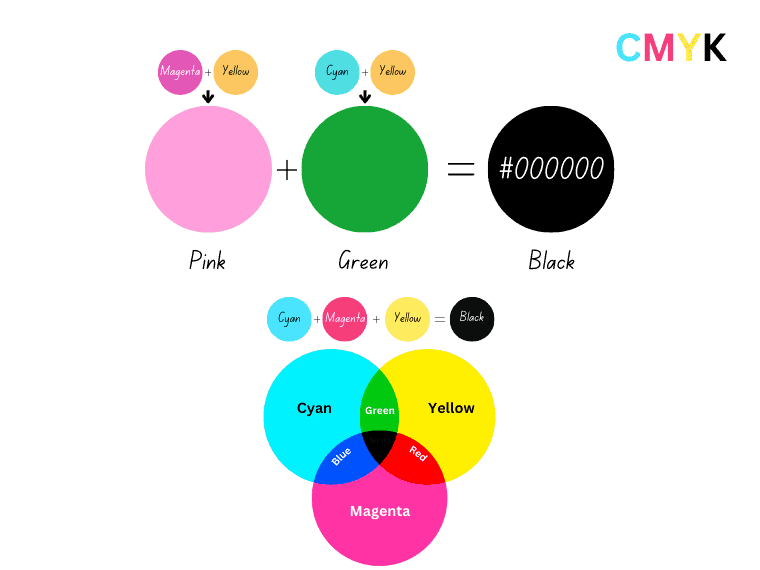
Mixing Pink and Green in the CMYK Color Model
CMYK color space is used in the printing industry. The primary colors, cyan, magenta, and yellow, make black.
However, using black ink is easier and cheaper than making it by mixing the three primary colors.
Furthermore, black is used as a key color to improve the clarity and depth of darker colors.
For this reason, black has been added to the model, symbolized by the letter K in the acronym.
CMYK is a subtractive color model. Thus, by mixing the three primary colors, the resulting color is black because all wavelengths of light are absorbed.
In the CMYK model, the more ink applied to the white paper, the more light is absorbed and the darker the color appears.
This differs from RGB, where mixing the three primary additive colors makes white. In RGB, the more color is added, the brighter the result.
Black Meaning
Black is at the opposite end of white. This color is associated with strength, elegance, and sophistication. However, black also intimidates and seduces.
Moreover, it symbolizes authority and prestige. It is also a color associated with formality.
On the other hand, it is associated with sadness, pessimism, and depression. That’s because black is the absence of light (darkness).
Green and Pink in Design
Pink doesn’t appear on traditional color wheels because it is not a spectral color but a tint of red. Thus, it’s not a pure hue but a range of red shades.
When it comes to physics, pink is not a spectral color. It’s more like a mix of wavelengths between red and purple light.
On the color wheel, green and pink are opposed, forming a color harmony when matched together. That’s because pink is a hint of red, and the complementary color to red is green.
Pink and green is one of the classic combinations that appear in modern interior design. These colors pair well together as they create balance.
Pink warms up a green tone but also calms and comforts. On the other hand, green tones offer freshness, keeping pink grounded and earthy.
Learn more about the colors that go with green.
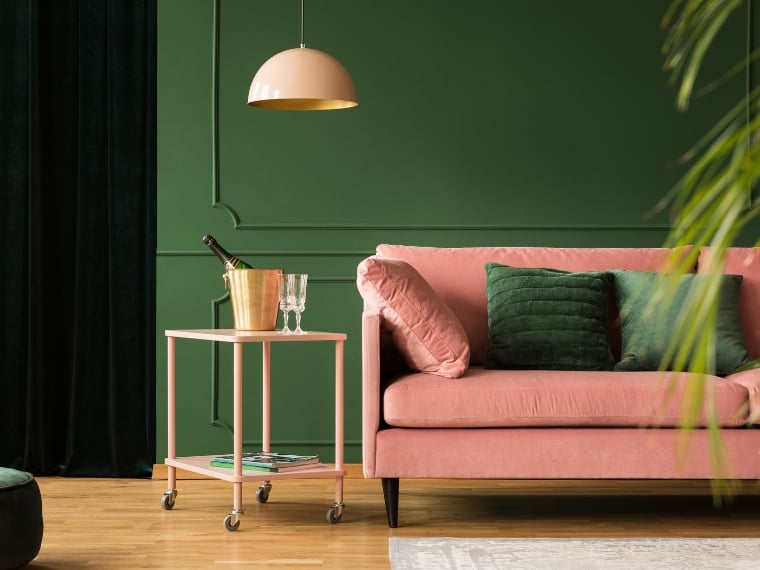
How Can Mixing Two Colors Have Multiple Results?
Mixing pink and green paint can produce different shades of brown or gray, depending on the specific shades of pink and green used.
When you mix pink and green, you essentially mix two complementary colors.
Complementary colors occupy opposite positions on the color wheel. They can neutralize each other when mixed, resulting in a dark, muddy color.
If the pink and green are light or pastel shades, mixing them can create a pale gray color. If the pink is a darker shade and the green is a lighter shade, the resulting color may be brownish-gray.
Conversely, if the green is a darker shade and the pink is a lighter shade, the resulting color may be grayish-brown.
Did you enjoy this article about what colors pink and green make? Please share it with your friends who might be interested in this mix.

